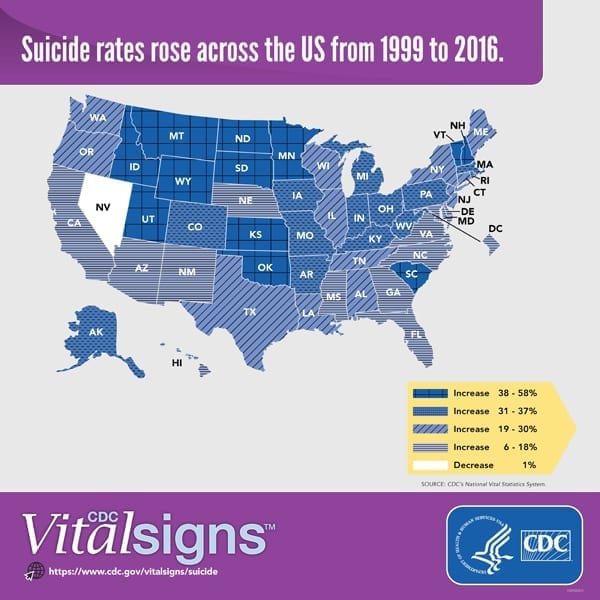Oh my child that I adore,
How can I make you love life once more?
To take all darkness from you and return it,
If I could do this it would all be worth it.
Our Resources
Our Community
Depression
Only half of all Americans experiencing an episode of major depression receive treatment. (NAMI)
Treatment
80% -90% of people that seek treatment for depression are treated successfully using therapy and/or medication. (TADS study)
Death
There is one death by suicide in the US every 12 minutes. (CDC)
Suicide
At 17.3%, Suicide is the 2nd leading cause of death for those between the ages of 10-24.
Gender Disparities
Male Suicide
Suicide among males is 4x’s higher than among females. Male deaths represent 79% of all US suicides. (CDC)
Female Depression
Females experience depression at roughly 2x’s the rate of men.(SMH)
Firearms
Firearms are the most commonly used method of suicide among males (51%). (CDC)
Female Suicide Attempts
Females attempt suicide 3x’s as often as males. (CDC)
Suicidal Contagion – A troubling issue we need to be aware of.
The Contagion of Suicide
In recent years, The Woodlands has seen a drastic spike in teen suicide. Suicidal Contagion could be the cause.
A study conducted by Madelyn S. Gould, Ph.D., M.P.H. (Columbia University and New York State Psychiatric Institute) and Alison M. Lake, M.A. (New York State Psychiatric Institute) (2013)
Evidence has accumulated to support the idea that suicidal behavior is “contagious” in that it can be transmitted, directly or indirectly, from one person to another.
Impact of Media Reporting Suicide:
More than 50 studies on nonfictional stories reported in newspapers, on television, and more recently on the Internet, have yielded consistent findings. Suicide rates go up following an increase in the frequency of stories about suicide (e.g., Hagihara et al., 2007). Moreover, suicide rates go down following a decrease in the frequency of stories about suicide (e.g., Motto, 1970).
Suicide Clusters:
A suicide cluster is an excessive number of suicides occurring in close temporal and/or geographical proximity (Gould et al., 1989). Clusters occur primarily among teenagers and young adults, with between 1 percent and 5 percent of teen suicides occurring in clusters (Gould, 1990; Gould et al., 1990; Hazell, 1993).
Impact on Adolescents of Exposure to a Suicidal Peer:
National Longitudinal Study of Adolescent Health (ADD Health) found that “teens who know friends or family members who have attempted suicide are about three times more likely to attempt suicide than are teens who do not know someone who attempted suicide” (Cutler et al., 2001).
Strategies to Prevent Suicide Contagion:
It is possible to intervene to mitigate media-driven suicide contagion by implementing media guidelines for suicide reporting (Gould, 2001; Pirkis and Nordentoft, 2011). Media guidelines can interrupt the transmission of suicidality by identifying the types of media reporting through which suicidality is likely to be transmitted, and by modifying the volume and content of media reporting, with resultant decreases in suicide rates. For example, suicides in the Vienna subway system decreased by approximately 75 percent in 1987 following implementation of media guidelines for reporting on subway system suicides (Etzersdorfer et al., 1992). Applying media guidelines to new electronic media, including social networking websites, presents a new challenge to the suicide prevention community (Pirkis and Nordentoft, 2011; Robertson et al., 2012).
Screening for suicide risk can also interrupt the transmission of suicidality by identifying in advance individuals who may be susceptible to suicide contagion (Gould et al., 2009). In addition, suicide screening works to alleviate that susceptibility by enabling services to be directed to at-risk individuals identified by the screen. Key settings for suicide screening include schools and primary care practices. A range of school- and community-based psychosocial programs may also work to alleviate susceptibility to suicide contagion by, for example, changing adolescent peer norms through positive messaging (Wyman et al., 2010), or educating and empowering parents to communicate with teens (Toumbourou and Gregg, 2002). Finally, research suggests that coordinated postvention/crisis intervention efforts following a death by suicide may minimize and contain the effects of suicide contagion (Poijula et al., 2001; Hacker et al., 2008).
Conclusion:
While the complex etiology of suicidal behavior is recognized (Gould et al., 2003), it has become increasingly apparent that suicide contagion exists and contributes to suicide risk along with psychopathology, biological vulnerability, family characteristics, and stressful life events. Strategies to prevent suicide contagion are essential and require ongoing evaluation.
References:
https://www.ncbi.nlm.nih.gov/books/NBK207262/
Substance Abuse and Mental Health.
Below are some studies covering how substance abuse affects mental health, and vice versa.
Substance Use, Depression and Mental Health Functioning in Patients Seeking Acute Medical Care in an Inner-City ED
“Those with depression and/or poor mental health functioning are at high risk for the physical and psychological consequences of substance use.”
A Comparison of Independent Depression and Substance-Induced Depression in Cannabis, Cocaine, and Opioid Dependent Treatment Seekers
” Independent depression has been found to be more highly associated with suicidality, with a greater number of symptoms, and with a greater number of lifetime depressive episodes.”
Meta-analysis of depression and substance use among individuals with alcohol use disorders
“Results support the hypothesized positive association of depression and concurrent alcohol use and impairment and general drug use and impairment.”
Drug Addiction as Risk for Suicide Attempts
“Suicide is closely linked to the substance use.”
One suffering from depression can only compound their troubles when also abusing substances.
More than half of people who died by suicide did not have a known diagnosed mental health condition at the time of death.
Common Causes: Relationship problems or loss, substance misuse; physical health problems; and job, money, legal or housing stress often contributed to risk for suicide.
Common Method: Firearms were the most common method of suicide used by those with and without a known diagnosed mental health condition.
Everyone can help prevent suicide:
– Learn the warning signs of suicide to identify and appropriately respond to people at risk. Find out how this can save a life by visiting: www.BeThe1to.comExternal
– Reduce access to lethal means – such as medications and firearms – among people at risk of suicide.
– Contact the National Suicide Prevention Lifeline for help: 1-800-273-TALK (8255). https://suicidepreventionlifeline.orgExternal
The media can avoid increasing risk when reporting on suicide by:
– Following and sharing recommendations available at reportingonsuicide.org (for example, avoiding dramatic headlines or explicit details on suicide methods);
– Providing information on suicide warning signs and suicide prevention resources; and, sharing stories of hope and healing.

Local Organizations dedicated to helping our community.
The Woodlands Behavioral Health & Wellness Center
111 Vision Park, Suite 250
Shenandoah, TX 77384



